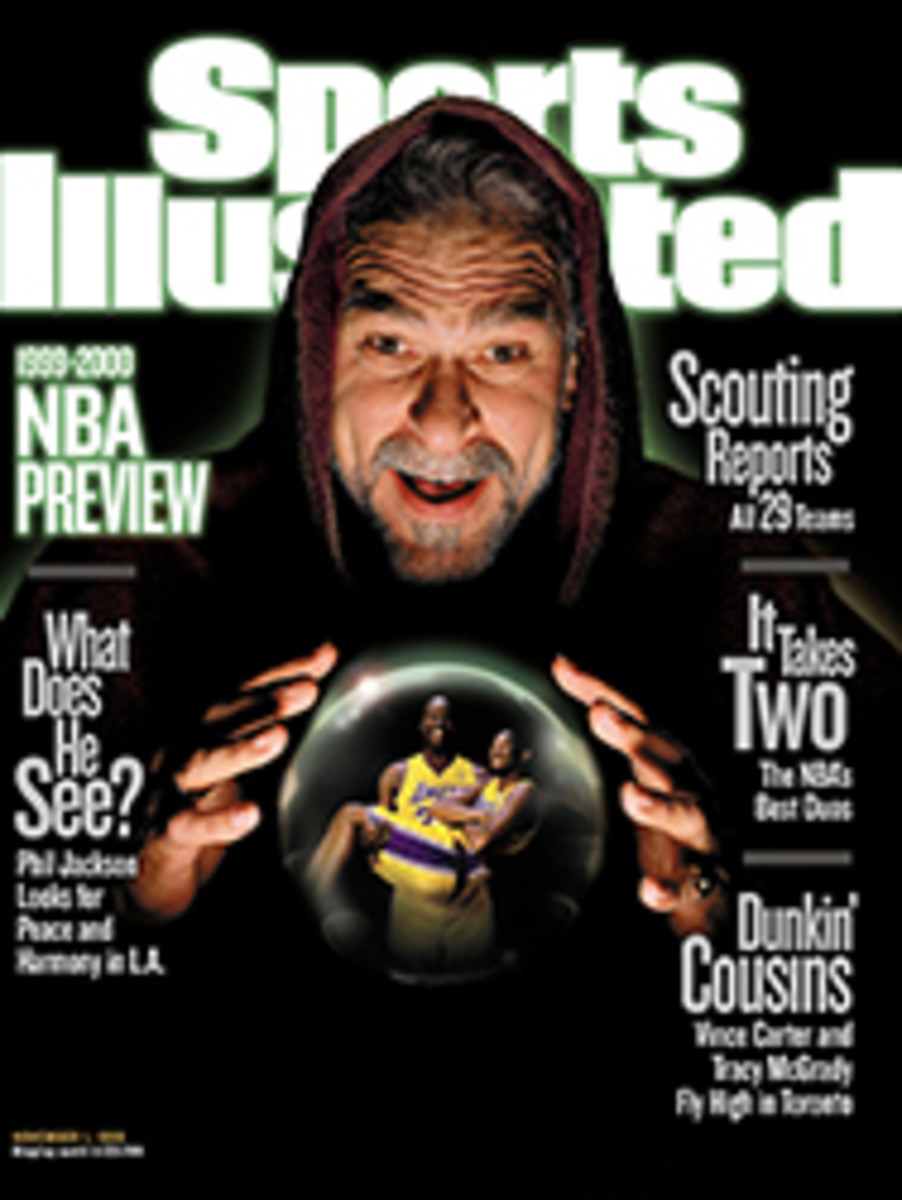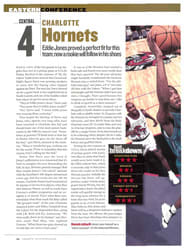
4 Utah Jazz Too old, too slow? You can say so, but Utah's vets will just say you're wrong
From the experts to the casual fans to the die-hard Rotisserie
geeks, the message has been sent to the Jazz: Don't bother. You
had your window of opportunity, and the window is closed. Take
your fingers off the sill and kindly move along.
But Utah cannot do that. Not Jerry Sloan, who after 11 seasons in
Salt Lake City still screams for the Jazz to run its
picture-perfect pick-and-roll as if he were doing it for the
first time. Not Karl Malone, one of the best power forwards ever
and the league's Most Valuable Player last season, who could have
gone elsewhere in search of that elusive ring but instead
re-signed with the only franchise he's ever known. And not
37-year-old John Stockton, the first-ballot Hall of Fame point
guard, who has grown weary, no doubt, of talk that he is too old
and too slow--yet not so weary to actually believe any of it.
To count the Jazz out before this season has started is to ignore
the accomplishments and commitment of Sloan, Malone and Stockton,
and they have each battled too long and too hard for that. So has
36-year-old guard Jeff Hornacek, who has announced that this will
be his last campaign. He could have walked away after the team's
second-round playoff loss last year, but he believes one little
break this season is all that will be needed to tip the scales in
favor of an experienced team like the Jazz. "I've been hearing we
missed our last chance to win the championship every year since I
got here," says Hornacek, "and this is my sixth season in Utah."
It would also be foolish to ignore the obvious: that Hornacek and
Stockton are past their primes, and that the 36-year-old Malone,
who suffered a back strain at the start of training camp and
missed most of the preseason, may well soon be past his. Yet none
of the three players have ever relied much on lightning speed or
jump-out-of-the gym athleticism. They have excelled because of
conditioning, toughness and guile, attributes that age well.
For some reason, though, those qualities were in surprisingly
short supply last year in the postseason. The Jazz looked
vulnerable--and, frankly, a tad scared--in edging the Kings three
games to two and bowing to the Trail Blazers in six. "To be
honest, you could see the writing on the wall, well before the
playoffs even started," Hornacek says. "The team didn't feel
right. It's hard to explain, really. It wasn't like there was one
big troublesome thing you could point to. It was just that we
weren't clicking right. Hopefully, whatever it was, it woke us
up."
Some in the Jazz organization say that the younger players last
season chafed at Sloan's unyielding strategy of featuring only
Malone and Stockton. That approach contributed, in part, to
swingman Shandon Anderson's decision to sign as a free agent with
the Rockets. As he left, Anderson talked of wanting to play a
larger role in a more up-tempo system.
Another source of friction was center Greg Ostertag, who served
as a whipping boy for coaches and teammates (particularly Malone)
last season as they tried to push him to elevate his game.
Ostertag's shortcomings long ago ceased to be merely physical;
the psychic damage of too many disappointing efforts is painfully
evident. "It's gotten to the point where Greg has a lot to
overcome," says Sloan. "Nobody likes anything he does, and that's
not fair."
Recognizing it needed help in the pivot, Utah declined to
re-sign Greg Foster and went fishing in the free-agent market.
It snagged fiery Olden Polynice, 34, who wore out his welcome in
Sacramento and Seattle by questioning the way he was used. Jazz
officials were warned that Polynice could be disruptive but
reasoned that the team's no-nonsense veterans would keep him in
line. Polynice proved to be a bright spot in training camp,
displaying an enthusiasm--and a willingness to run the
floor--that Ostertag often lacks. Says Sloan, "The guy has not
given us one problem."
The biggest hurdle for Utah to overcome would seem to be the
departure of Anderson, who provided low-post scoring when Malone
was being rested. "Obviously, it hurts us in terms of depth,"
Hornacek says. "But beyond that, I'm not sure how bad off it
leaves us. All I know is two years ago, Adam Keefe started at
small forward and we won 62 games. It seems pretty simple to me.
If you're looking to fill a void, just put Adam back in there."
Malone's injury wasn't the only one to befall the Jazz in the
preseason. After complaining of dizziness, Ostertag missed a pair
of preseason games. Howard Eisley, the steady backup point guard
who enabled Stockton to play just 28.2 minutes per game last
season, was slowed by a groin strain. Hornacek was in and out of
the exhibition lineup with a strained right quadriceps.
Sloan will have to integrate some new faces: Rookies Quincy Lewis
and Torraye Braggs will get looks at the forward spots. With
Anderson gone, Bryon Russell will be asked to upgrade his
offensive game and play both shooting guard and small forward.
Citing recent championship teams, Hornacek believes that a
shortened rotation might be a blessing in disguise, and he is
willing to log as many minutes as needed.
"[Team owner] Larry Miller asked me once, 'How long do you want
to play?'" Hornacek says. "I told him, 'Probably until we no
longer have a chance of winning it.' Every year I believe we have
a chance, but I guess you finally get to the point when it's time
to stop even if you still do think you can win it all. I told
Larry this would be it for me. He said, 'Don't shut the door
yet.'"
At least not while Utah has good reason to think the window is
still open.
--Jackie MacMullan
[BOX]
FAST BREAKDOWN
STARTING FIVE [3 1/2 stars]
BENCH [2 1/2 stars]
COACH [4 1/2 stars]
FRONT OFFICE [2 1/2 stars]
CHEMISTRY [2 1/2 stars]
COLOR PHOTO: JOHN W. MCDONOUGH LAST SHOT Declaring this his final season at age 36, Hornacek believes he'll retire with a ring.
By the Numbers
1998-99 record: 37-13 (tied for first in Western Conference)
Coach: Jerry Sloan (12th season with Jazz)
1998-99 PER GAME POINTS FG % REBOUNDS TURNOVERS
AVERAGES (rank) (rank) (rank) (rank)
JAZZ 93.3 (9) 46.5 (2) 41.3 (16) 16.3 (25)
OPPONENTS 86.8 (5) 41.3 (5) 38.6 (2) 14.9 (20)
In Fact
Between them, Karl Malone and John Stockton have a spot among
the alltime NBA leaders in nearly every major statistical
category. But the only one in which they're both in the top 10
is turnovers (Malone is fifth, Stockton sixth).
Projected Lineup
STARTERS PVR* 1998-99 KEY STATS
SF Bryon Russell 74 12.4 ppg 5.3 rpg 1.5 apg 46.4 FG%
As starter in '98-99 and had career highs in scoring and
rebounding
PF Karl Malone 5 23.8 ppg 9.4 rpg 4.1 apg 49.3 FG%
Received votes on 117 of 118 ballots in last season's MVP voting
C Olden Polynice[#] 115 7.7 ppg 8.9 rpg 0.9 apg 47.2 FG%
Hit just 30.9% (29 of 94) of his free throws last season
SG Jeff Hornacek 133 12.2 ppg 3.3 rpg 4.0 apg 42.0 3FG%
Finished in the top 10 in both free throw and three-point
percentages
PG John Stockton 28 11.1 ppg 2.9 rpg 7.5 apg 48.8 FG%
Alltime assists leader had lowest average since becoming starter
in '87-88
BENCH PVR* 1998-99 KEY STATS
G Howard Eisley 187 7.4 ppg 1.9 rpg 3.7 apg 44.6 FG%
Career stats: 5.4 ppg, 3.0 apg in regular season; 5.2 ppg, 2.9
apg in playoffs
F Quincy Lewis[#](R) 191 23.1 ppg 5.9 rpg 1.4 apg 45.7 FG%
At Minnesota he led Big Ten in scoring last season (sixth in
nation)
C Greg Ostertag 226 5.7 ppg 7.3 rpg 0.5 apg 47.6 FG%
Fifth in league with career-high 2.73 blocked shots per game
F Adam Keefe 266 4.0 ppg 3.2 rpg 0.6 apg 45.2 FG%
Only top 10 pick from '92 draft with career scoring average in
single digits
F Pete Chilcutt[#] 292 3.6 ppg 2.5 rpg 0.7 apg 36.6 FG%
Played in 20 of 22 playoff games for 1994-95 NBA champion Rockets
[#]New acquisition
(R) Rookie (statistics for final college year)
*PVR: Player Value Ranking (explanation on page 102)

